Bulking agents
- Inulin
- Maltodextrin
- Polydextrose
- Cellulose
- Other polysacchatides
Origin
Over-consumption of sugars and desserts, along with the the much publicized attention to obesity and high blood pressure in many populations, have prompted health conscious consumers to seek low sugar or no sugar foods.
Function
Sucrose performs multiple functions in baked goods by:1
- Providing sweetness
- Controlling moisture retention
- Influencing air incorporation
- Stabilizing air bubbles
- Limiting starch swelling during baking
When formulating for sugar-free baking, it is important to find alternative ingredients which can mimic sucrose functionality and sweetness. Sucralose, the only non-calorie sweetener derived from sugar, is unique in its sweetening intensity and heat stability. Its usage in baking applications have provided consumers with a new generation of great tasting, healthy and reduced-calorie food products.2
The following table highlights sweetening power and other functional properties of sugar substitutes:1,2
| Sweetener | Sweetness (relative to sucrose) | Comments |
| Saccharin | 300 |
|
| Aspartame | 180-200 |
|
| Acesulfame | 200 |
|
| Neotame | 7000 – 13000 |
|
| Stevia | 200 – 300 |
|
| Sucralose | 600 |
|
| Erythritol | 150 |
|
Applications
Despite their high sweetness compared to sucrose, sugar substitutes lack in their contribution to the body and texture of baked products. Bulking sweeteners, on the other hand, may result in products with a similar body but lack in taste and flavor.
No significant differences in chiffon cake firmness were found when 50% sucrose was replaced by a sucralose–erythritol mixture.3 When inulin was used to partially replace sucrose, no significant differences in firmness were observed.4
Using oligofructose, lactitol or maltitol as sugar replacers in muffins showed similar behavior to sucrose in terms of batter rheology and increased starch gelatinization temperature. Fructose and mannitol led to cakes of poor quality.5
Sweet bread made with saccharin, aspartame and acesulfame-K displayed comparable behavior to control bread. In biscuits, these sweeteners resulted in adverse effects in dough, addition of sorbitol reversed this effect.6
Nutrition
Consumption of high levels of sugars can raise the glycemic index and consequently leads to acute increase in postprandial plasma glucose and insulin levels, obesity and coronary heart disease in addition to dental problems.
Partial replacement of sugar with stevia or inulin in muffins reduced sugar release after 20 and 60 minutes of digestion. This effect was greatest when sugar was 100% replaced with stevia and/or inulin and was maintained for 120 minutes.7
FDA regulations8
| Sweetener | Regulatory status |
| Acesulfame
Potassium (Ace-K) |
Approved as a sweetener and flavor enhancer in foods generally (except in meat and poultry) |
| Aspartame | Approved as a sweetener and flavor enhancer in foods generally |
| Saccharin | Approved as a sweetener only in certain special dietary foods and as an additive used for certain technological purposes |
| Neotame | Approved as a sweetener and flavor enhancer in foods generally (except in meat and poultry) |
| Certain high purity steviol glycosides purified from the leaves of Stevia rebaudiana (Bertoni) Bertoni | ≥95% pure glycosides
Subject of GRAS notices for specific conditions of use |
| Sucralose | Approved as a sweetener in foods generally |
References
- Nip, W.K. Bakery Products: Science and Technology. Hui, H. (Ed.), Blackwell Publ. 2014, pp. 582.
- Chapello, W.J. The use of sucralose in baked goods and mixes. Cereal Foods World, 1998, 43, pp: 716-717.
- Akesowan, A. Quality of reduced-fat chiffon cake prepared with erythritol-sucralose as replacement for sugar. Pakistan J. Nutr. 2009, 8, 9, pp: 1383-1386.
- Rößle, C., Ktenioudaki, A. & Gallagher, E. Inulin and oligofructose as fat and sugar substitutes in quick breads (scones): a mixture design approach. European Food Research and Technology, 2011, 233, pp: 167–181
- Psimouli, V. and Oreopoulou, V. The effect of alternative sweeteners on batter rheology and cake properties. J. Sci Food Agric. 2012, 92, 1, pp: 99-105.
- Venkateswara Rao, J. and Indrani, D. Studies on the use of artificial sweeteners in sweet bread and biscuits. J. Food Sci. Technol, 1989, 26, 3, pp: 142-144
- Gao, J., Brenna, M.A., Mason, S.L. and Brennan, C.S. Effect of sugar replacement with stevianna and inulin on the texture and predictive glycaemic response of muffins. Int. J. Food Sci. Technol. 2016, 9, pp: 1979-1987.
- High-Intensity Sweeteners Permitted for Use in Food in the United States. https://www.fda.gov/food/food-additives-petitions/additional-information-about-high-intensity-sweeteners-permitted-use-food-united-states

